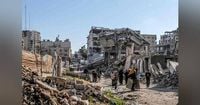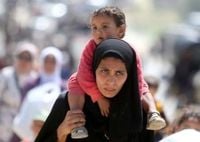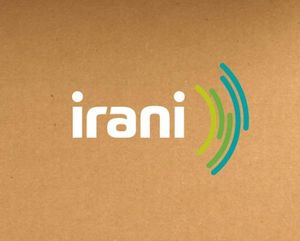On April 14, 2025, Israel presented a new ceasefire proposal to Egypt aimed at mediating negotiations concerning the ongoing conflict with Hamas in the Gaza Strip. Egyptian media reported that this proposal was shared with a Hamas delegation currently in Egypt to discuss potential ceasefire terms.
The proposed ceasefire reportedly includes a controversial condition: the disarmament of Hamas in Gaza. This stipulation has sparked immediate backlash from Hamas officials, who labeled it a "red line" that should not be crossed. The Hamas delegation expressed surprise at the unexpected nature of the Israeli proposal during their discussions with Egyptian officials.
In a statement issued on the same day, Hamas acknowledged the proposal and indicated they are "carefully considering" its terms, promising to respond as quickly as possible. This cautious approach suggests that while the proposal has raised significant concerns, Hamas is still weighing its options in the face of escalating tensions.
Meanwhile, developments on the ground have been equally dramatic. By April 15, Israeli forces completed the installation of a strategic military corridor known as the Morag corridor, which separates Rafah, located at the southernmost point of the Gaza Strip, from northern Khan Yunis. This new corridor effectively encircles Rafah, which lies on the border with Egypt.
Israeli media reports indicate that the military is preparing to transform Rafah into a buffer zone, restricting residents from entering. This move is largely viewed as a tactic to prevent the smuggling of weapons into Gaza, a significant concern for Israeli authorities. Hamas has been known to utilize underground tunnels from the Egyptian side to facilitate the smuggling of arms into Rafah, making this area a critical supply route for the group.
The establishment of the Morag corridor is anticipated to cut off this vital supply line, further isolating Hamas. Reports suggest that the area between the Morag corridor and the Egyptian border, often referred to as the Philadelphi Corridor, will become a designated buffer zone, encompassing around one-fifth of the entire Gaza Strip.
Prior to the outbreak of conflict in October 2023, approximately 200,000 people lived in the Rafah area. However, many have since evacuated due to the ongoing violence. There are even discussions about the potential destruction of all buildings within Rafah, which would further complicate any future return for displaced residents.
As tensions rise, U.S. media has reported that the Israeli army has plans to occupy approximately 25% of Gaza, a move that is likely to draw international scrutiny and condemnation. In February 2025, U.S. President Trump unveiled a controversial plan to relocate Gaza residents outside the area, a proposition that has gained traction among some Israeli officials, including Prime Minister Netanyahu, who has shown support for this initiative.
Dr. Said Sadek, an academic from Egypt-Japan University of Science and Technology, highlighted the dire situation in Rafah, noting that many buildings have already suffered damage due to Israeli military actions. He pointed out that the establishment of the Morag corridor and the management of Rafah by Israeli forces effectively "completely destroy" the hopes of residents returning to their homes, potentially leading to an involuntary relocation outside the region.
The conflict, which has seen a significant escalation in hostilities since its inception, continues to evolve with each passing day. The intricate dynamics between Israel, Hamas, and the broader international community raise numerous questions about the future of peace in the region. As both sides navigate through these complex negotiations, the humanitarian implications for the civilian population remain a pressing concern.
As the situation develops, the world watches closely, hoping for a resolution that can bring lasting peace to a region long plagued by conflict.





